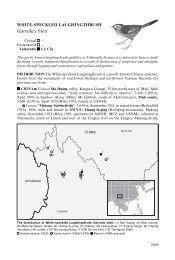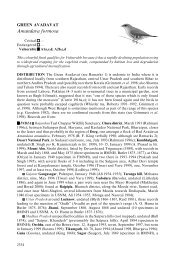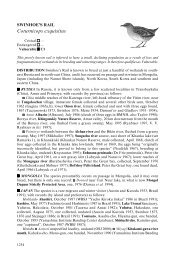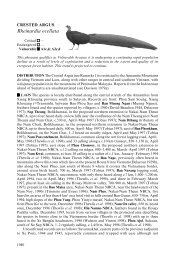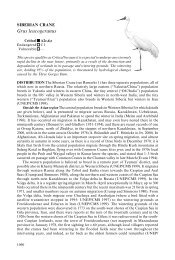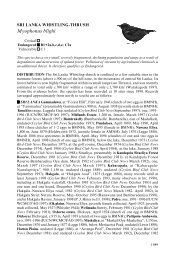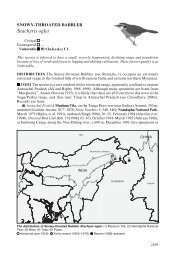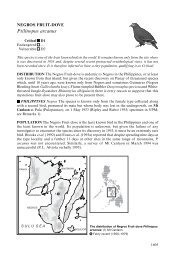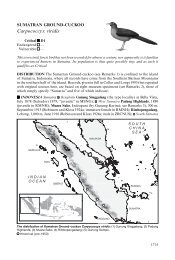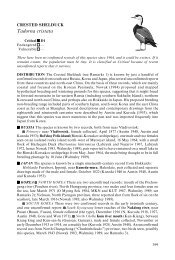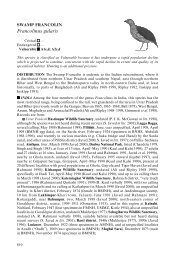Gyps bengalensis - BirdBase
Gyps bengalensis - BirdBase
Gyps bengalensis - BirdBase
You also want an ePaper? Increase the reach of your titles
YUMPU automatically turns print PDFs into web optimized ePapers that Google loves.
<strong>Gyps</strong> <strong>bengalensis</strong><br />
frontier” where, in places, they were still “frequently seen”, with breeding recorded from<br />
northern Kedah, north of Alor Star (=Alor Setar, Madoc 1947, 1951; Wells 1999), but the<br />
last confirmed breeding there was at Gunung Keriang in December 1950 (Medway and Wells<br />
1976), and by 1950–1951 it was “scarce” in Kelantan (Wells 1999). At this stage, over half a<br />
century ago, the species was already essentially dependent on slaughterhouse offal (D. R.<br />
Wells in litt. 2000). By 1973 it was “scarce throughout the peninsula”, apparently occurring<br />
only as a rare non-breeding visitor (Medway and Wells 1976), for example a record from<br />
Kampung Penyirang, Trengganu in June 1979 (Wells 1984).<br />
Laos This species was once abundant in suitable habitat throughout Laos (Thewlis et al.<br />
1998). In Tranninh it was found commonly (Delacour and Jabouille 1927b), and even in the<br />
mid-twentieth century it was still abundant there and also in Savannakhet province (David-<br />
Beaulieu 1944, 1949–1950). In Champasak and Attapu provinces it was common, but<br />
outnumbered by the Red-headed Vulture (Engelbach 1932). However, it is now restricted to<br />
the southern part of Champasak and Attapu provinces (Thewlis et al. 1998), with populations<br />
well below carrying capacity and of “miserably low” breeding output (J. W. Duckworth in<br />
litt. 2000), and it may soon become extinct (Thewlis et al. 1998).<br />
Recent records come from: Xe Pian NBCA, where vultures were found sporadically in<br />
open habitats and agricultural areas in the northern zone, and daily on the Xe Kong plains<br />
where flocks 40–60 vultures (including this species, with a maximum of 11 positively identified)<br />
were seen on water buffalo carcasses in January 1993, 2–8 were seen daily in May 1995<br />
(Thewlis et al. 1998), two in September 1996 and 6–17 between Senamsai and Ban Sompoy<br />
in December 1997 (Duckworth et al. 1999); the Mekong river at Ban Hongkhong (= Ban<br />
Hangkhon), Champasak province, on both the Lao and Cambodian sides, where at least<br />
one was positively identified in a party of ten vultures in April 1996 (Thewlis et al. 1998), and<br />
at least six in February 1997 (Robson 1997); and Xe Xou, where one was reported in February<br />
1996 (Thewlis et al. 1998). Unidentified vultures were reported from Ban Hinlat in Bolaven<br />
Southwest PPA, and one (possibly this species) was seen near Ban Khiam in August 1996<br />
(Thewlis et al. 1998, Evans et al. 2000).<br />
Cambodia The species was once abundant in suitable habitat throughout the country,<br />
but by the 1960s it was regarded as uncommon (Thomas 1964), and it is now restricted to a<br />
few areas, with populations well below carrying capacity and of “miserably low” breeding<br />
output (J. W. Duckworth in litt. 2000). Recent records are known from Lumphat road in<br />
January 1997, 26 (in groups of up to 12) in June–July 1997 in Lumphat district, and one in<br />
Oyadao district in June 1997 (Oriental Bird Club Bull. 27 [1998]: 61–66, Goes 1999a); at least<br />
11 out of flock of 31 vultures at Khonyek, Mondulkiri province, in June 2000 (Oriental Bird<br />
Club Bull. 32 [2000]: 66–76); and at carcasses in Mondulkiri province in April 1994 (Mundkur<br />
et al. 1995a).<br />
Vietnam Historically, this species was abundant in suitable habitat in central and south<br />
Vietnam (J. W. Duckworth in litt. 2000), being very common on the Pleiku plateau (David-<br />
Beaulieu 1939), “common” in South Annam (Delacour et al. 1928), and “the commonest<br />
vulture” in south Vietnam, being “often seen in large groups” (Wildash 1968). It is now<br />
almost extinct (Thewlis et al. 1998), with only one recent record in Dak Lak province (Le<br />
Xuan Canh et al. 1997), but none was recorded during recent surveys in Dak Lak province in<br />
February–May 1998 (Brickle et al. 1998), and none was found during surveys in December<br />
1989–March 1990 at sites throughout Vietnam (Robson et al. 1990).<br />
China There are apparently no recent records (P. Alström in litt. 2000), and the species’s<br />
present status is unknown, but it is likely to be scarce or rare.<br />
ECOLOGY Habitat In India, the White-rumped Vulture is found in cities, towns and villages<br />
near cultivation, and in light woodland and open areas (Grimmett et al. 1998). In Pakistan,<br />
it prefers cultivated areas with scattered trees and a high human population, being attracted<br />
603



